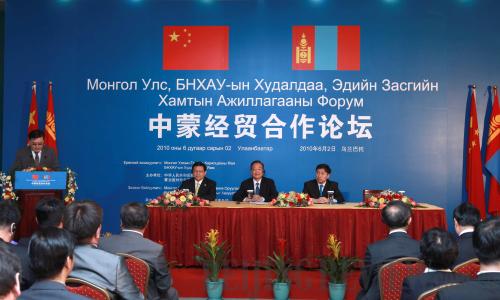| 
Chinese and Mongolian leaders have strengthened exchanges since the beginning of this year. Only weeks after Mongolian Prime Minister Sukhbaataryn Batbold attended the Boao Forum for Asia in China in April, Mongolian President Tsakhia Elbegdorj paid a state visit to the country. During the visit, he also attended the opening ceremony of the 2010 World Expo in Shanghai on April 30. In early June, Chinese Premier Wen Jiabao visited Mongolia for the first time.
 |
|
NEW IMPETUS: Chinese Premier Wen Jiabao attends a forum on economic and trade cooperation along with Mongolian Prime Minister Sukhbaataryn Batbold (right) in Ulan Bator on June 2 (PANG XINGLEI) |
Regarding trade as a priority in bilateral relations, China has been Mongolia's largest trading partner and foreign investor for years. Its development assistance to its northern neighbor has also increased. All this is attributable, among other factors, to the two countries' improved political relations, the complementary nature of their economies and China's economic takeoff.
Robust growth
China and Mongolia established diplomatic relations in October 1949, shortly after the People's Republic of China was founded. The two countries, however, did not establish a stable framework for their business ties until the 1990s. Official Chinese statistics show bilateral trade increased 10-fold from 1998 to 2008, soaring from $243 million to $2.438 billion.
Impacted by the world financial crisis, two-way trade fell 1.7 percent to $2.397 billion in 2009, with China's exports and imports standing at $1.058 billion and $1.339 billion, respectively. Despite the drop, China remained Mongolia's largest trading partner for the 11th consecutive year. More than 90 percent of consumer goods in the Mongolian market are from China.
By 2009, China had been Mongolia's biggest foreign investor for 12 years in a row. Statistics from the Economist Intelligence Unit indicate China invested $116 million in Mongolia in 2009, raising its total investment in the country to $1.011 billion. Mongolian statistics show China's investment accounts for more than half of the total foreign investment and is three times the investment of Japan, the United States, South Korea and the EU combined. Chinese investment is mainly distributed in sectors such as mineral exploitation, infrastructure construction, livestock product processing, commerce and catering. Mongolia's investment in China, though small in amount, is also growing.
After economic aid from the former Soviet Union became unavailable in the early 1990s, Mongolia began to conduct economic restructuring and asked the international community for assistance. In August 1991, China and Mongolia signed agreements on loans and mutual investment. In June 2002, they signed agreements on China's economic and technological assistance to Mongolia and Mongolia's postponement of paying off Chinese debt.
With these documents in place, China has become a major assistance provider to Mongolia. From 2002 to 2007, it provided Mongolia with 3 billion yuan (approximately $443 million) in assistance and loans, exceeding the total amount it had offered in the previous 50 years. In recent years, China has provided Mongolia 60 million-80 million yuan ($8.9 million-$11.8 million) in financial assistance every year. In March 2010, the China Development Bank granted Mongolia a loan of $3 billion for the country's highway and railway construction.
Improvements in political relations between China and Mongolia have given an impetus to their business ties. Since the early 1990s, the two countries have reinvigorated suspended relations. In 1994, they signed the Treaty on Friendly Relations and Cooperation and have since exchanged frequent high-level visits, leading to enhanced mutual understanding. In 2003, the two countries' heads of state reached a consensus on establishing a "good neighborly partnership of mutual trust." The agreement ushered in a new era of bilateral relations, giving a boost to business ties.
During his visit to Mongolia from June 1-2, Premier Wen reached out to representatives from various sectors of Mongolian society, including entrepreneurs by attending a trade forum in Ulan Bator. The two countries also signed documents on border management, and economic and technological cooperation.
Mongolia is a scarcely populated inland nation, with a population density of only two people per square km. The size of its economy is small. Agriculture and animal husbandry are Mongolia's leading economic sectors, engaging 40.2 percent of its population.
While exporting primary goods such as minerals and agricultural products, Mongolia needs to import industrial products such as machinery, electrical equipment and textiles. With its manufacturing prowess, China is in a position to meet Mongolia's needs.
China's rapid economic development has created new opportunities. For instance, Mongolia became an authorized destination for outbound Chinese tourists in March 2006. To date, some 700,000 Chinese tourists have visited Mongolia, far more than the number of Russian, South Korean and Japanese tourists. China has become the largest source of tourists for Mongolia, as well as the most popular tourist destination for Mongolians.
| 